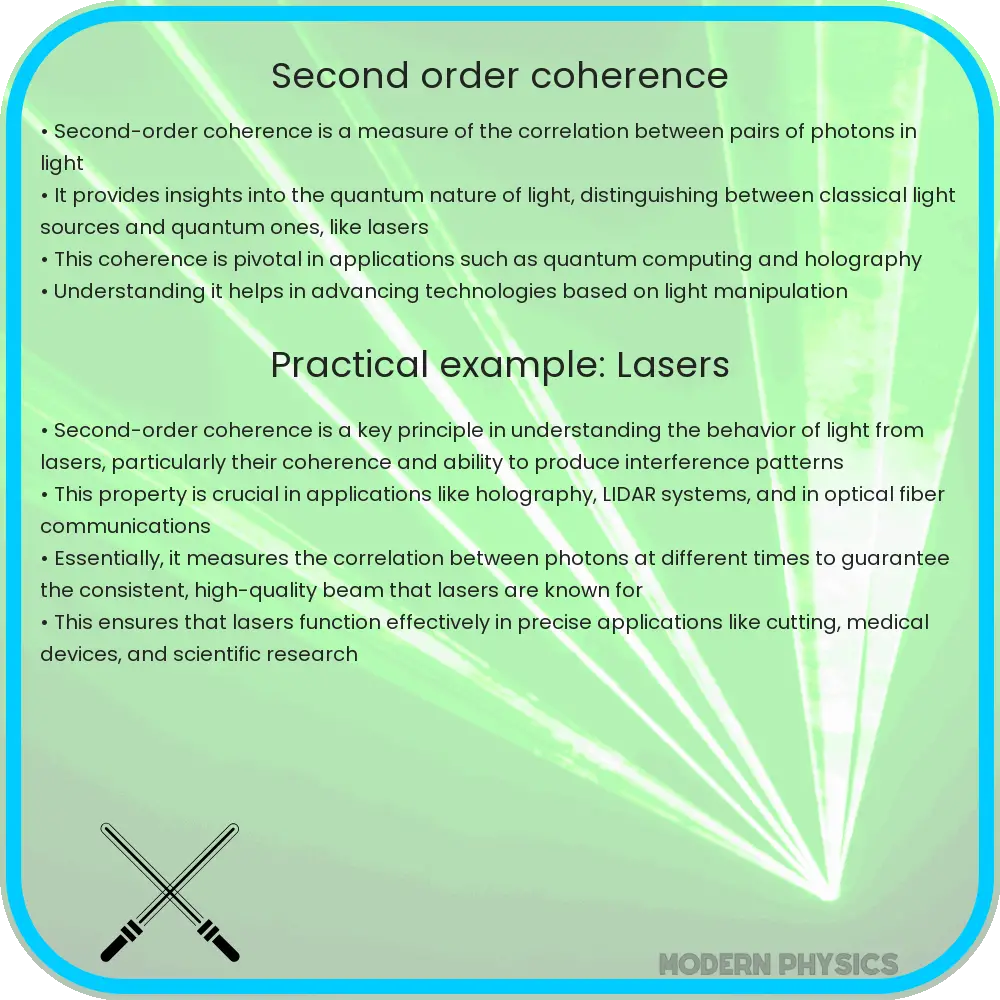Explore the fascinating world of second-order coherence in quantum theory, uncovering its impact on quantum optics, computing, and secure communication.

Understanding Second-Order Coherence in Quantum Theory
Second-order coherence is a fundamental concept in quantum optics that describes the correlation and interference patterns of light at a quantum level. This concept extends beyond classical optics, providing insights into the behavior of photons when they interact with each other or with matter. Understanding second-order coherence is essential for grasping the principles of quantum interference, photon correlation, and the overall behavior of light in quantum mechanics.
The Basis of Second-Order Coherence
At its core, second-order coherence revolves around the measurement of the correlation between pairs of photons. Unlike first-order coherence, which deals with the amplitude correlations of a light wave at different points in space or time, second-order coherence focuses on the intensity correlations. This distinction is crucial for understanding phenomena such as the Hanbury Brown and Twiss effect, quantum entanglement, and the foundations of quantum cryptography.
Quantum Interference and Photon Correlation
Quantum interference is a hallmark of second-order coherence, where the probability amplitudes of photons interfere with one another. This interference can be constructive or destructive, leading to observable patterns that defy classical explanations. For instance, in the double-slit experiment with single photons, the detection of interference patterns when one photon passes through at a time is a direct consequence of second-order coherence. This phenomenon illustrates how photons are correlated not just with other photons but with potential paths they can take.
Experimental Measurements of Second-Order Coherence
The degree of second-order coherence is quantitatively measured by the second-order correlation function, \(g^{(2)}(\tau)\), where \(\tau\) represents the time delay between detections of photon pairs. A \(g^{(2)}(0) < 1\) indicates antibunching, a quantum mechanical property where photons are more likely to arrive separately, while a \(g^{(2)}(0) > 1\) suggests bunching, where photons tend to arrive in pairs or groups. These measurements are crucial in experiments involving photon sources like single-photon emitters and in applications such as quantum computing and secure communication.
Through the exploration of second-order coherence, quantum optics provides a deeper understanding of the intricate nature of light, paving the way for advanced technological applications that leverage the quantum mechanical properties of photons.
Applications and Implications of Second-Order Coherence
The study of second-order coherence has led to significant advancements in various fields, including quantum computing, quantum cryptography, and optical imaging. In quantum computing, the manipulation of quantum states of light, characterized by their coherence properties, enables the development of quantum bits or qubits, which are the building blocks of quantum information processing. Similarly, in quantum cryptography, second-order coherence and the associated photon correlation properties are exploited to ensure secure communication channels that are theoretically immune to eavesdropping.
Furthermore, second-order coherence has profound implications in optical imaging techniques, such as quantum microscopy and ghost imaging, where the quantum nature of light is used to achieve resolutions beyond the classical diffraction limit or to image objects with light that has never interacted with them. These applications underscore the practical significance of understanding and harnessing second-order coherence in advancing both fundamental science and technological innovation.
Challenges and Future Directions
Despite the progress in exploiting second-order coherence, challenges remain in fully realizing its potential. The delicate nature of quantum states requires sophisticated experimental setups to measure and manipulate photon correlations with high precision. Moreover, as we push the boundaries of quantum technologies, new theoretical and practical challenges emerge, necessitating ongoing research and development.
Future directions in the study of second-order coherence include the exploration of higher-order coherence properties for more complex quantum systems, the development of novel quantum materials and devices based on coherence principles, and the integration of quantum optical technologies into existing infrastructure. The continued investigation into second-order coherence will likely unveil new quantum phenomena and pave the way for innovative applications that could transform information technology, communication, and imaging.
Conclusion
Second-order coherence in quantum theory offers a window into the fundamental nature of light and its quantum mechanical behaviors. Through the study of interference patterns, photon correlations, and the quantum properties of light, scientists and engineers are developing technologies that leverage these principles for cutting-edge applications in computing, communication, and imaging. Despite the challenges posed by the quantum world, the potential of second-order coherence and its applications continues to inspire advancements in science and technology. As we deepen our understanding and develop new tools to measure and manipulate quantum states of light, the future of quantum optics and its applications appears both promising and boundless.
